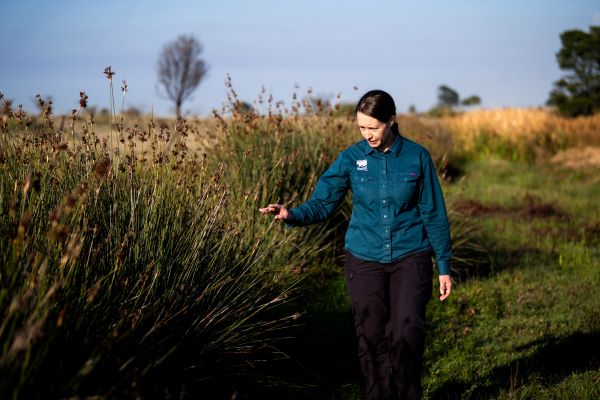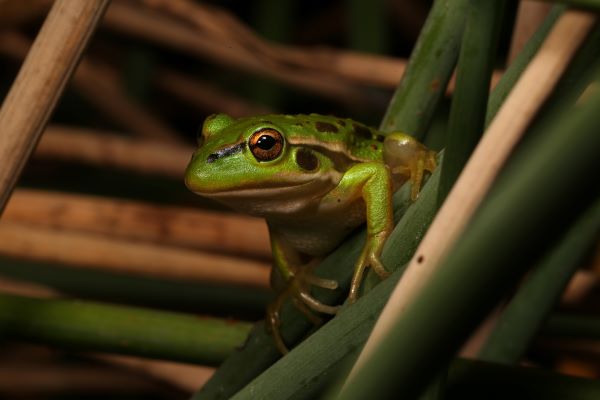When the sun sets over the grasslands, and traffic noise from the nearby highway begins to ease, Curly Sedge Creek begins to reveal its secrets.
During a night-time frog survey, something rare catches the beam of a torch: the delicate, distinctive spirals of Curly Sedge, unmistakable even in the dark. Nearby, the low, throaty call of a Growling Grass Frog cuts through the stillness. For Yasmin Kelsall, Environmental Planning Lead for MCMC, it's a moment of quiet revelation – proof that this overlooked stretch of creek could still offer refuge for threatened species.
Thanks to the support of our community during last year’s Growling Grass Frog campaign, MCMC has been able to confirm the species' presence in and around Curly Sedge Creek. Surveys have been conducted at four sites – two on the creek itself, one at O’Herns Swamp, and another on Merri Creek.

The Growling Grass Frog, listed as vulnerable at both state and national levels, has suffered dramatic declines since the 1970s. Urban expansion has stripped away much of its habitat, leaving only isolated patches of suitable wetland in which the species can breed, forage and shelter. Finding the frog here was a hopeful sign.
“We now know that Growling Grass Frogs are resident in Curly Sedge Creek and surrounds,” says Yasmin. “They come into the creek to breed in spring and summer, then move out into the grasslands and stony knoll areas in winter.”
Growling Grass Frogs need a mix of habitat types to survive: still and slow-moving water to lay eggs in, submerged vegetation for tadpoles, rocky, warm spaces to bask and a mix of vegetation and open spaces to forage and to hide from predators. That makes Curly Sedge Creek ideal – if we can maintain the right conditions.
This year, our campaign to protect Curly Sedge Creek, will also directly benefit the frogs. Invasive weeds like Spiny Rush, Lobed Needle Grass and Chilean Needle Grass are clogging the creek and crowding out native vegetation. Their removal will create open spaces and healthier waterway conditions.
“The work we’re asking our community to support will include sensitively managing these invasive species – and that will benefit Growling Grass Frogs too,” says Yasmin. “Managing these exotic species leaves more open space for frogs to forage in. It also helps them fight off the devastating Chytrid fungus, which is such a threat to these beautiful frogs.”
MCMC’s Ecological Restoration Program Manager Michael Longmore adds that the frogs’ return is a signal that the broader landscape still has conservation value. “The greatest threat to Growling Grass Frogs is loss of habitat,” he says.
“While the presence of frogs at Curly Sedge Creek is encouraging, it’s also a reminder of how important these places are. As our city grows, so too does the pressure on habitat. Knowing that frogs are here gives us another reason to value and protect the creek – not just for curly sedge, but for all the creatures that live there.”
“Curly Sedge Creek is like a little hidden paradise,” Yasmin adds. “You can be walking across wide-open plains, then suddenly come across these meandering waterways. It really feels reminiscent of the landscape that used to exist across northern and western Melbourne.”
Our current campaign will help protect this special place, ensuring that both Curly Sedge and Growling Grass Frogs are able to survive – and thrive – in Merri Creek and its tributaries.
Find out more about how you can support Growling Grass Frogs and Curly Sedge Creek.
 Growling Grass Frog (Litoria raniformis), photograph by Geoff Heard.
Growling Grass Frog (Litoria raniformis), photograph by Geoff Heard.





 Merri Creek Management Committee. 2 Lee St, East Brunswick, Victoria, Australia 3057
Merri Creek Management Committee. 2 Lee St, East Brunswick, Victoria, Australia 3057